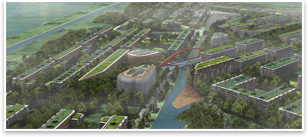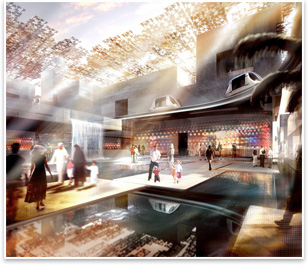| Sustainable Cities: The Race Is On
by Michael J. Crosbie, PhD, AIA
 Summary: While folks in the U.S. debate about whether or not to turn the Arctic National Wildlife Refuge into a vast stretch of Swiss cheese in our myopic quest for more crude, people in other parts of the world are looking to design their way out of the fossil fuel pinch. Surprisingly enough, these initiatives are being pursued in two of the most unlikely places: China (which has emerged as one of the world’s more robust energy consumers) and the United Arab Emirates (even they have figured out that nothing lasts forever). The schemes are bold, big, ambitious, and will be (the designers hope) inspirational models for a sustainable future. Summary: While folks in the U.S. debate about whether or not to turn the Arctic National Wildlife Refuge into a vast stretch of Swiss cheese in our myopic quest for more crude, people in other parts of the world are looking to design their way out of the fossil fuel pinch. Surprisingly enough, these initiatives are being pursued in two of the most unlikely places: China (which has emerged as one of the world’s more robust energy consumers) and the United Arab Emirates (even they have figured out that nothing lasts forever). The schemes are bold, big, ambitious, and will be (the designers hope) inspirational models for a sustainable future.
 Dongtan, China Dongtan, China
Described by its designers, at Arup, as an “eco-city,” Dongtan is to be built on the third largest island in China, at the mouth of the Yangtze River near Shanghai. The city will occupy only a third of the 86-square-kilometer site, leaving the rest open for organic farming. The city will be made up of a number of towns; the first, for 10,000 people, will comprise three villages and is planned for completion by 2010, although construction is seriously behind schedule.
Arup says that energy will be supplied by a combination of wind, solar, biomass, and recycling waste as fuel. Dongtan will be laced with bike paths and footways to encourage people to commute to work without adding carbon to the atmosphere. The architecture is planned to be compact and low-scale, between three and six stories. Part of Arup’s plan is to achieve a diverse mix of employment, housing, and entertainment choices that will draw a variety of people. But with escalating construction costs, living there might not be as affordable as proposed.
 Masdar, Abu Dhabi Masdar, Abu Dhabi
Another contestant in the green city sweepstakes is Masdar, to be built in Abu Dhabi, one of the Arab Emirates (and one of the world’s largest oil producers). The six-square-kilometer city for 50,000, planned by Foster + Partners, is to be built in two phases. The first entails the construction of a huge photovoltaic plant that will power the city to be built next to it. The city will be surrounded by a wall to buffer it from a nearby airport and contain its high density.
The most important design features of Masdar are easy access to public transportation and the use of traditional design to aid in cooling the city. The plan is to ban cars from Masdar, which will offer residents public transport options within a 200-meter walking distance. The options include mass transit and a fully automated personal rapid transit system. As for mitigating the desert climate, Foster envisions shady narrow streets—more like mews—that will weave through neighborhoods. Overhead, these mews will be shaded with canopies that convert sunlight into energy. Canals lining the mews will help bring air temperatures down though moisture—a very old yet effective technique for temperature control.
Outside the walled city will be a collection of facilities and generation plants: fields of PV collectors, a collection of solar mirrors to produce steam for heating and cooling, a wind farm, a desalination plant, water and sewage treatment plants, and recycling centers. The goal is to create a city without waste. Whatever can’t be recycled will be used as fuel to generate power. According to the designers, none of this is too far out to be realized—all the technology currently exists.
 Toward carbon-free Toward carbon-free
Will it ever happen? Maybe not entirely, although the Masdar Initiative has some powerful partners, such as MIT, Royal Dutch Shell, General Electric, and Rolls Royce. A first phase is to be completed next year, with a target of 2016 for the entire city. Adrian Smith + Gordon Gill Architecture is designing Masdar’s Headquarters.
What’s more important right now is the message that projects such as Masdar and Dongtan send to the rest of the world: It’s time to stop thinking about more oil rigs and to start designing for a carbon-free future.
|



 Dongtan, China
Dongtan, China Masdar, Abu Dhabi
Masdar, Abu Dhabi Toward carbon-free
Toward carbon-free